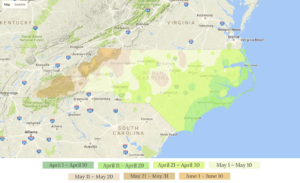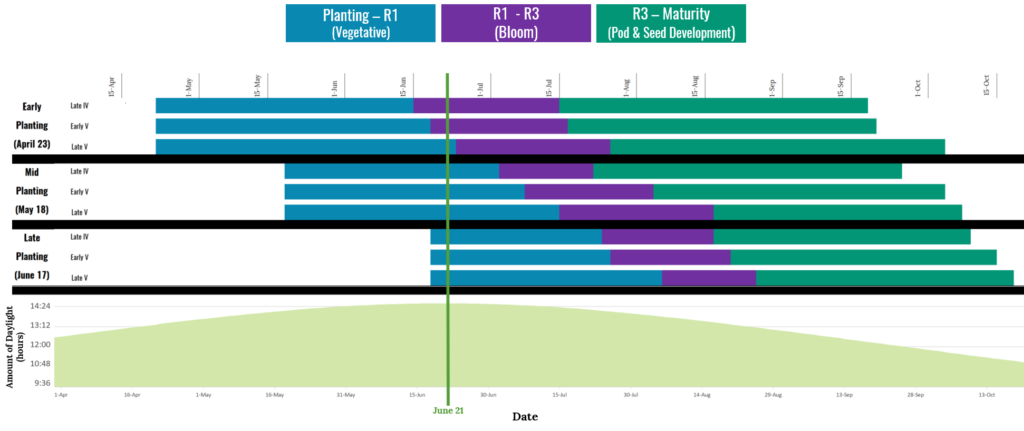Over the last two weeks, we have discussed results from a planting date by maturity group study the North Carolina Soybean Producers Association sponsored. If you missed those posts catch up here in Part 1 and Part 2.
As a quick reminder, 8 different varieties (four late 4’s, two early 5’s, and two late 5’s) were evaluated at three different planting dates – early (mid to late-April), mid (mid-May), and late (mid-June). We saw a strong yield increase when planting early compared to planting late (on average a 7.2 bu/ac difference). But, when we broke that data down to individual locations we saw that correlation wasn’t nearly as strong, especially in the Coastal Plain region.
This data demonstrates perfectly that there is no “one size fits all” approach to selecting maturity groups and planting dates for NC soybean growers. What works on one farm will likely not work on the next.
This week we’re going to look at that data a little more, specifically why planting early may contribute to higher yields.
One way states in the Mid-South have increased soybean yields over the last 20 years is by moving to an Early Soybean Production System which is based on early planting (late March through mid-April) of early-maturing (MG IV – MG V) soybean varieties. This system has worked really well in states such as Mississippi and Arkansas. In Mississippi, this system has helped raised the average state yield from 21 bu/ac in the 1980’s to 47 bu/ac last year.
In North Carolina, planting soybeans in mid-March is pretty risky as our average last frost date is not until mid-April but there may be the potential to increase yield by planting IV’s or V’s in mid to late April. As you can see below, most of Eastern North Carolina is clear of frost by the end of April.
One of the keys to growing soybeans is to maximize light interception. I’m sure you’ve all heard Dr. Dunphy’s famous line that we need to “get the plants big enough, quick enough to harvest enough light to maximize yields.” But how do we do that?
Our longest day occurs on the summer solstice, June 21. Agronomists that have worked with this Early Soybean Production System suggest having soybeans at R1 to R3 near the longest day of the year so they are capturing the greatest amount of light when it is needed the most – for setting and filling pods.
As part of this research, we recorded dates that each variety by planting date treatment reached R1, R3, and maturity. The trends were very similar for each location and for all varieties at a given maturity group, so the data presented below is compiled across all locations.
The graph below is the average time between different growth stages for the different maturity groups (late 4, early 5, late 5) and planting dates (Early, Mid, Late) tested. At the bottom, the number of hours of daylight for each day is shown in the light green arch. These intervals are averages and will vary some from year to year and environment to environment.
The green vertical line on the graph is at about June 21. If our goal is to get between R1 – R3 by June 21, really our best option in NC is a late April to early May planting of a group 4 or early group 5 variety.
Here’s another way to look at the same data. You’ll notice that the later the maturity group, the more days the variety spends in vegetative growth. Also, planting date gets later, the time spent in the vegetative stages decreases.
One reason the late 4 and early 5 varieties yield the highest when planted at the end of April is that we are able to maximize the amount of vegetative growth before June 21. And on the other hand, one reason many of the late 5 varieties out-yielded the earlier varieties when planted late was that they have more time for vegetative growth.
Like we discussed last week, I’m not suggesting you go and plant all your acres with a group IV in late April because there are many other factors to consider. One of the most important being will you have time to cut beans when they reach maturity? Most of the earlier maturing varieties will not hold long in the field and you must be ready to go when they are.
However, transitioning a portion of your acres to an earlier planting date may be something to consider. One advantage of this is risk mitigation. If you stagger planting dates you may miss drought, heavy rain events or hurricanes on one group that hit another. You also spread out your harvest window.
Good luck as you begin to plan for 2018. If you think an early planting date may work on your operation, I’d suggest you try it on a small portion of your acres and see if you can make the system work for you.









